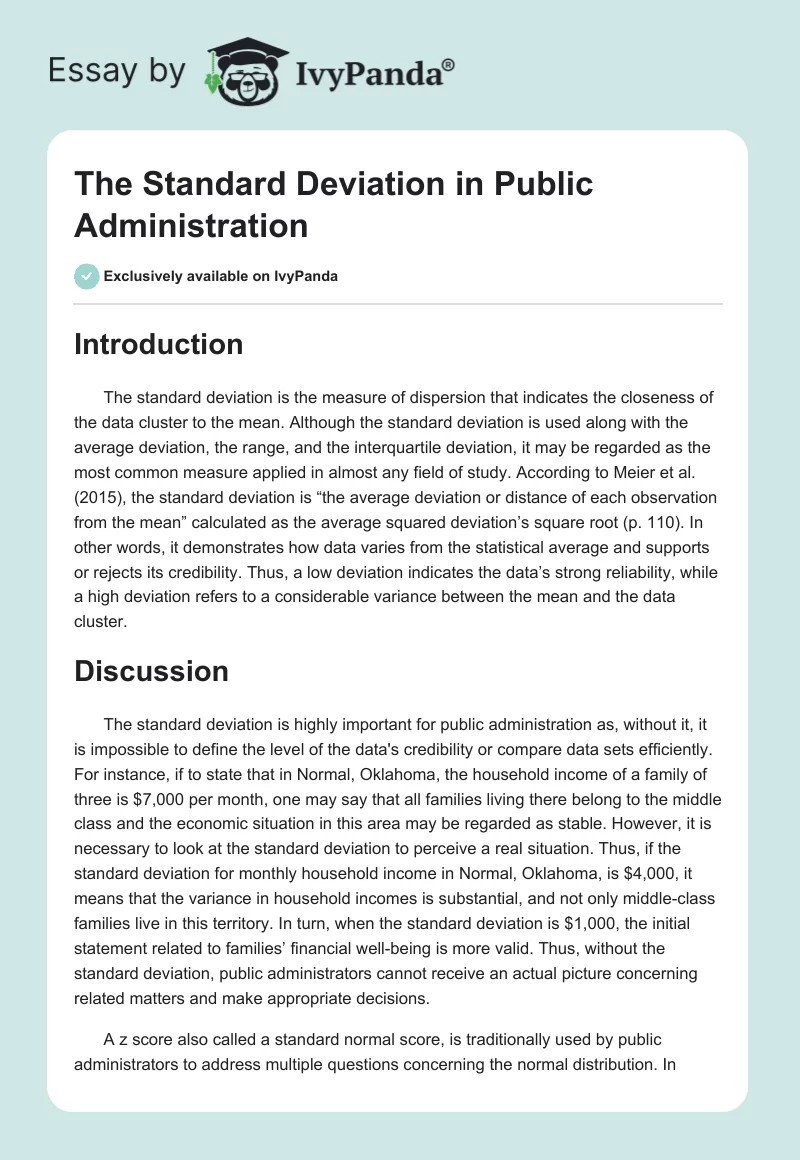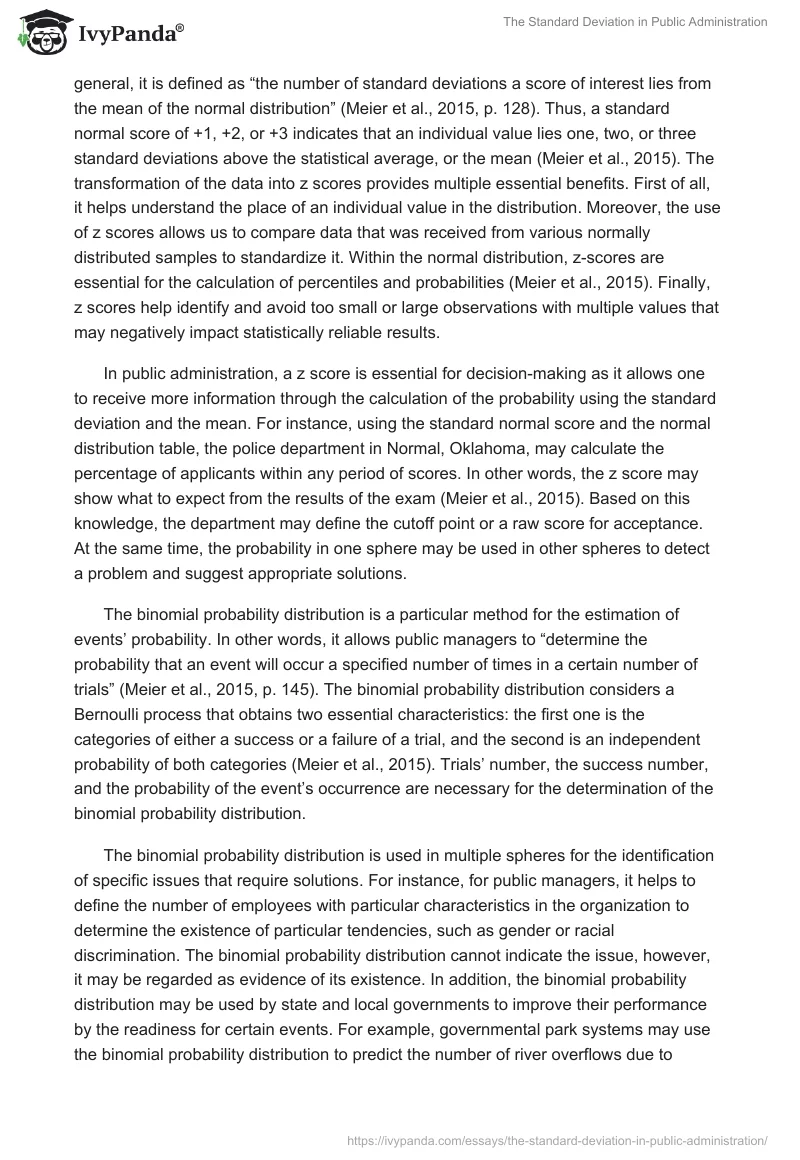Introduction
The standard deviation is the measure of dispersion that indicates the closeness of the data cluster to the mean. Although the standard deviation is used along with the average deviation, the range, and the interquartile deviation, it may be regarded as the most common measure applied in almost any field of study. According to Meier et al. (2015), the standard deviation is “the average deviation or distance of each observation from the mean” calculated as the average squared deviation’s square root (p. 110). In other words, it demonstrates how data varies from the statistical average and supports or rejects its credibility. Thus, a low deviation indicates the data’s strong reliability, while a high deviation refers to a considerable variance between the mean and the data cluster.
Discussion
The standard deviation is highly important for public administration as, without it, it is impossible to define the level of the data’s credibility or compare data sets efficiently. For instance, if to state that in Normal, Oklahoma, the household income of a family of three is $7,000 per month, one may say that all families living there belong to the middle class and the economic situation in this area may be regarded as stable. However, it is necessary to look at the standard deviation to perceive a real situation. Thus, if the standard deviation for monthly household income in Normal, Oklahoma, is $4,000, it means that the variance in household incomes is substantial, and not only middle-class families live in this territory. In turn, when the standard deviation is $1,000, the initial statement related to families’ financial well-being is more valid. Thus, without the standard deviation, public administrators cannot receive an actual picture concerning related matters and make appropriate decisions.
A z score also called a standard normal score, is traditionally used by public administrators to address multiple questions concerning the normal distribution. In general, it is defined as “the number of standard deviations a score of interest lies from the mean of the normal distribution” (Meier et al., 2015, p. 128). Thus, a standard normal score of +1, +2, or +3 indicates that an individual value lies one, two, or three standard deviations above the statistical average, or the mean (Meier et al., 2015). The transformation of the data into z scores provides multiple essential benefits. First of all, it helps understand the place of an individual value in the distribution. Moreover, the use of z scores allows us to compare data that was received from various normally distributed samples to standardize it. Within the normal distribution, z-scores are essential for the calculation of percentiles and probabilities (Meier et al., 2015). Finally, z scores help identify and avoid too small or large observations with multiple values that may negatively impact statistically reliable results.
In public administration, a z score is essential for decision-making as it allows one to receive more information through the calculation of the probability using the standard deviation and the mean. For instance, using the standard normal score and the normal distribution table, the police department in Normal, Oklahoma, may calculate the percentage of applicants within any period of scores. In other words, the z score may show what to expect from the results of the exam (Meier et al., 2015). Based on this knowledge, the department may define the cutoff point or a raw score for acceptance. At the same time, the probability in one sphere may be used in other spheres to detect a problem and suggest appropriate solutions.
The binomial probability distribution is a particular method for the estimation of events’ probability. In other words, it allows public managers to “determine the probability that an event will occur a specified number of times in a certain number of trials” (Meier et al., 2015, p. 145). The binomial probability distribution considers a Bernoulli process that obtains two essential characteristics: the first one is the categories of either a success or a failure of a trial, and the second is an independent probability of both categories (Meier et al., 2015). Trials’ number, the success number, and the probability of the event’s occurrence are necessary for the determination of the binomial probability distribution.
The binomial probability distribution is used in multiple spheres for the identification of specific issues that require solutions. For instance, for public managers, it helps to define the number of employees with particular characteristics in the organization to determine the existence of particular tendencies, such as gender or racial discrimination. The binomial probability distribution cannot indicate the issue, however, it may be regarded as evidence of its existence. In addition, the binomial probability distribution may be used by state and local governments to improve their performance by the readiness for certain events. For example, governmental park systems may use the binomial probability distribution to predict the number of river overflows due to excessive rainfalls during a particular period. In the same way, this method may be applied to the work of police or fire departments for the modeling of events’ probability. In this case, these services will be more prepared for emergencies, such as fires or crimes, for more efficient response or even prevention.
The Poisson distribution is one type of probability distribution that exists along with the exponential and the hypergeometric probability distributions. It is based on a Poisson process, “a pattern of behavior when some event occurs at varying, random intervals over a continuum of time, length, or space” (Meier et al., 2015, p. 159). Similar to other probability distributions, the Poisson distribution follows a Bernoulli process as it refers to the event’s occurrence or absence and the independence of these categories (Meier et al., 2015). However, the main difference between Bernoulli and Poisson processes is the unknown number of trials in the latter. In addition, for a Poisson process, the success or failure of the event does not impact the probability of other events.
Conclusion
In public administration, the Poisson distribution is used to model the probability of events’ occurrence in particular time intervals taking into consideration that these events have a constant mean number. In this way, the Poisson distribution may contribute to the improvement of various public services’ performance. For instance, the definition of a probable number of crimes during a night may optimize the work of the police and other agencies to provide an efficient response, such as arrests and psychological support for victims. In addition, the Poisson distribution is applied for the prediction of natural disasters, such as floods or earthquakes (Cupal et al., 2015). Scientists and environmental engineers record calamities’ average number in a particular location within a given period to use this data for the calculations of the Poisson distribution. In turn, these calculations will provide the probability of disasters’ occurrence in the future. In this case, the Poisson distribution allows to prevent mass property destruction and life losses.
References
Cupal, M., Deev, O., & Linnertova, D. (2015). The Poisson regression analysis for occurrence of floods. Procedia Economics and Finance, 23, 1499-1502.
Meier, K. J., Brudney, J. L., & Bohte, J. (2015). Applied statistics for public and nonprofit administration (9th ed.). Cengage Learning.


